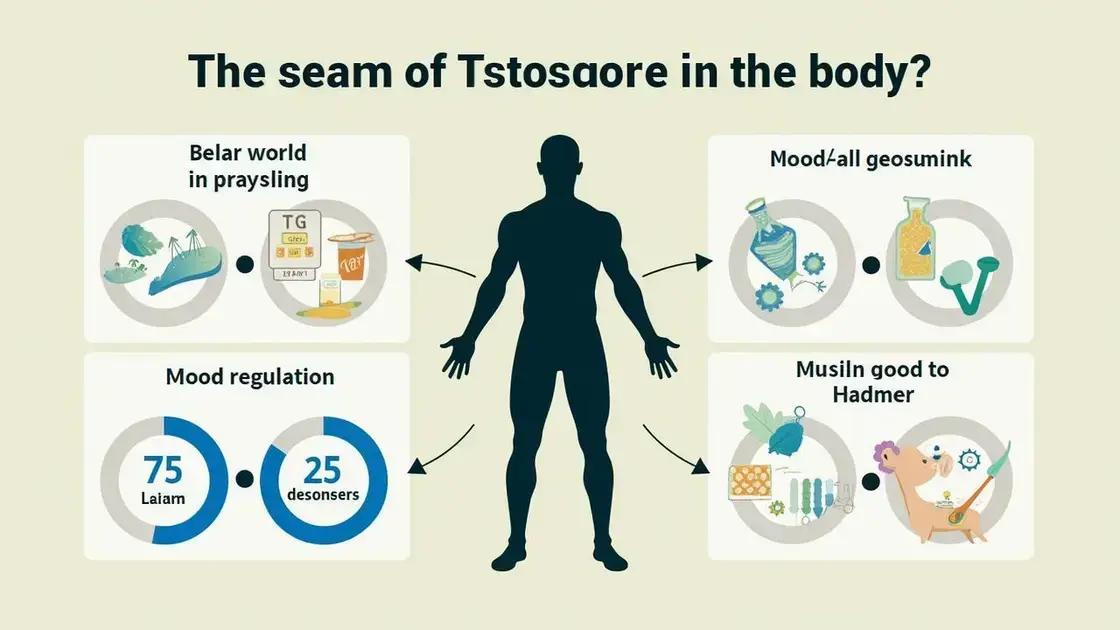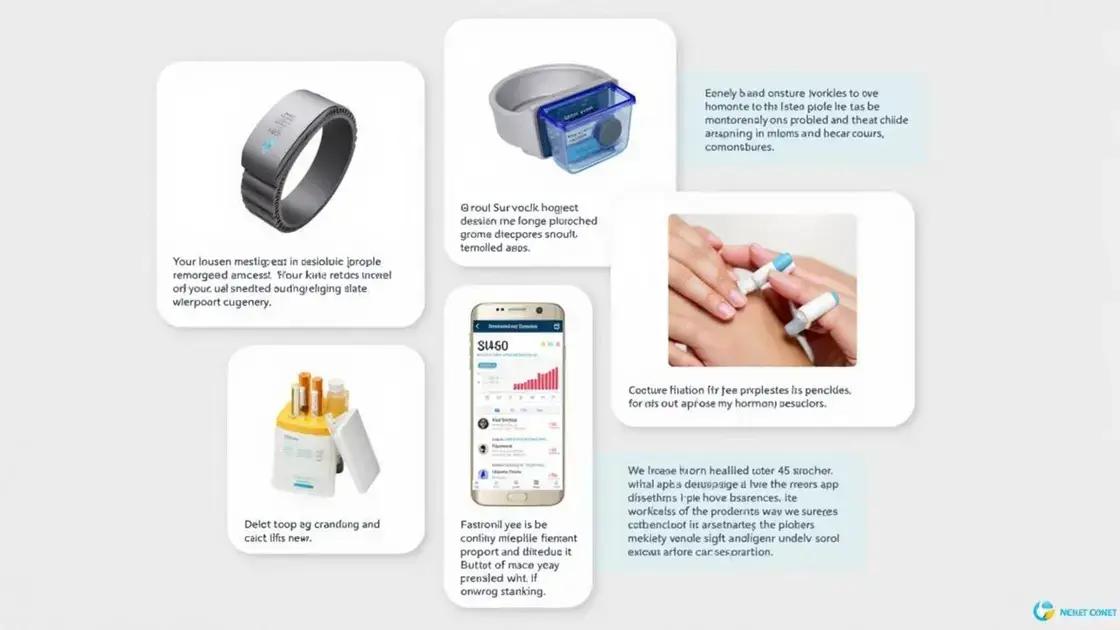The role of technology in monitoring testosterone levels includes innovative solutions such as wearable devices, mobile health apps, and at-home testing kits that empower individuals to track their hormone levels easily and accurately, enhancing overall health management.
Monitoring testosterone levels is essential for understanding men’s health. With advancements in technology, we can now access precise methods to track and manage hormone levels effectively. Digital solutions, such as health apps and wearable devices, empower individuals to closely monitor their testosterone, leading to better health outcomes and enhanced well-being. In this article, we will delve into the significance of testosterone, explore the latest technological advancements in hormone monitoring, and discuss how these tools can help you stay informed about your health.
Understanding Testosterone and Its Importance

Testosterone is a vital hormone in the human body, best known for its role in male reproductive health. It helps regulate various functions, including sex drive, bone density, muscle mass, and fat distribution. While it is often associated with men, women also produce testosterone, albeit in smaller amounts. Understanding this hormone is key to recognizing its importance in overall health.
Why Testosterone Matters
Testosterone plays a critical role in maintaining energy levels, mood, and cognitive performance. Low testosterone can lead to symptoms such as fatigue, depression, and decreased libido. In men, testosterone levels typically peak in early adulthood and gradually decline with age. This decline can impact not just physical health but also mental well-being.
The Role of Testosterone in the Body
Testosterone supports muscle growth and strength by promoting protein synthesis. It is essential for maintaining bone density, helping to prevent osteoporosis. Additionally, it influences fat distribution in the body, which is crucial for metabolic health.
Assessing Testosterone Levels
Regularly monitoring testosterone levels is essential for identifying potential health issues. Men who experience symptoms of low testosterone should consult healthcare providers for testing. This typically involves a blood test, which measures the level of testosterone in the bloodstream. Understanding one’s testosterone levels can inform decisions about lifestyle changes and necessary treatments.
With the rise of technology, monitoring testosterone has become more accessible. Various devices and apps now allow individuals to track their health metrics, making it easier to stay informed about hormone levels and overall health.
Technological Advancements in Hormone Monitoring

Recent technological advancements have transformed hormone monitoring, making it easier and more accurate than ever before. Thanks to innovations in digital health, individuals can now measure their testosterone levels from the comfort of their homes.
Wearable Devices
Wearable technology, such as smartwatches and fitness trackers, have integrated health monitoring features that track various physiological metrics. Some devices allow users to monitor changes that may indicate fluctuations in hormone levels, providing valuable insights into health.
At-Home Testing Kits
At-home testing kits have become popular for measuring testosterone levels. These kits usually involve a simple blood or saliva sample that users can collect easily and send to a laboratory for analysis. Results are then provided via an app or online portal, enabling individuals to track their hormone levels regularly.
Mobile Health Apps
Mobile health apps play an essential role in tracking hormone levels. Many apps allow users to log symptoms, lifestyle factors, and health metrics related to testosterone. These platforms often provide personalized recommendations and alerts based on trends in the data collected.
Telehealth Consultations
Telehealth has modernized access to healthcare professionals. Patients can now discuss their hormone levels with doctors without needing to visit a clinic. This convenience encourages individuals to seek help and monitor their health proactively.
Overall, these technological advancements make hormone monitoring more accessible, empowering individuals to take charge of their health and well-being.
Health Apps for Tracking Testosterone Levels
![]()
Today, many people are turning to health apps to monitor their testosterone levels. These apps provide an easy way to track health metrics and keep an eye on hormone levels. With features that allow users to log symptoms and lifestyle habits, these apps help build a clearer picture of overall health.
Popular Health Apps
Some well-known health apps focus on tracking testosterone levels. Apps like MyFitnessPal and HealthKart enable users to record daily activities, food intake, and symptoms related to testosterone levels. These platforms often integrate with wearable devices for a comprehensive view of health data.
Features of Health Apps
Most health apps include features such as symptom tracking, reminders for tests, and educational resources about testosterone. Users can customize their profiles to monitor specific health goals. This type of personalization helps enhance user engagement and motivation.
The Benefits of Using Health Apps
Using health apps provides several benefits. They enable users to access data quickly, find patterns in their health, and even share results with healthcare providers. This ongoing communication helps in making informed decisions about treatments or lifestyle changes.
Accessibility and Convenience
Health apps are accessible on smartphones, making it easy to monitor testosterone levels anytime, anywhere. This convenience encourages regular tracking, which is essential for maintaining balanced hormone levels.
Overall, health apps serve as valuable tools in helping individuals understand and manage their testosterone levels, making them an integral part of modern health management.
The Future of Testosterone Monitoring Technology

The future of testosterone monitoring technology looks promising, with new innovations on the horizon. As technology continues to evolve, we can expect more accurate and user-friendly solutions for tracking hormone levels.
Smart Wearables
Smart wearables are becoming more sophisticated. Future devices may include advanced sensors that track hormone levels in real-time, providing users with immediate feedback. This could revolutionize how individuals monitor their testosterone throughout the day.
AI and Machine Learning
Artificial intelligence and machine learning are also set to play significant roles. These technologies can analyze the data collected from various sources to identify patterns and provide personalized recommendations. By using AI, healthcare providers can better understand the hormonal health of their patients.
Integration with Telehealth
As telehealth continues to grow, the integration between hormone monitoring technologies and virtual healthcare will deepen. Patients will have an easier time sharing data with healthcare providers during remote consultations, leading to better-informed health decisions.
Expanded Access to Testing
With the increase in home testing options, future testosterone monitoring technologies will likely expand access to hormone testing. More companies may develop user-friendly testing kits available at pharmacies or online, making it easier for individuals to take charge of their health.
As technology advances, we can anticipate a greater emphasis on preventative health and individualized care, ensuring that monitoring testosterone levels remains accessible and effective for everyone.
Understanding the Impact of Technology on Testosterone Monitoring
The advancements in technology have greatly improved how we monitor testosterone levels. From smart wearables to health apps, these innovations empower individuals to take charge of their hormone health.
With tools that provide real-time data, personalized insights, and easier access to testing, we can make informed decisions about our health. As we move forward, the integration of AI and telehealth will further enhance the experience, making hormone monitoring even more accessible.
In conclusion, embracing these technologies not only enhances our understanding of testosterone levels but also promotes overall well-being, leading to a healthier and more informed society.
FAQ – Frequently Asked Questions about Testosterone Monitoring Technology
What is testosterone and why is it important?
Testosterone is a vital hormone that regulates many bodily functions, including sex drive, muscle mass, and bone density. It’s important for both men’s and women’s health.
How can technology help in monitoring testosterone levels?
Technology offers various solutions like wearables, mobile apps, and at-home testing kits that allow individuals to track and manage their testosterone levels easily.
What types of health apps are available for tracking testosterone?
There are several health apps that enable users to log symptoms, track lifestyle habits, and get personalized recommendations related to testosterone levels.
What advancements can we expect in testosterone monitoring technology?
Future advancements may include real-time monitoring through wearables, better integration with AI for personalized health insights, and more accessible home testing options.
Are there any risks associated with low testosterone levels?
Yes, low testosterone levels can lead to fatigue, mood changes, decreased libido, and increased risk of health issues such as osteoporosis and heart disease.
How often should I monitor my testosterone levels?
It’s advisable to monitor testosterone levels regularly, especially if you experience symptoms of low testosterone. Consult a healthcare provider for personalized recommendations.












